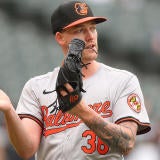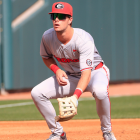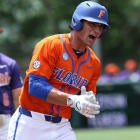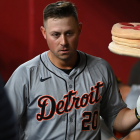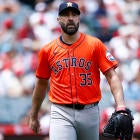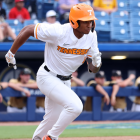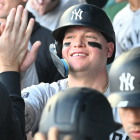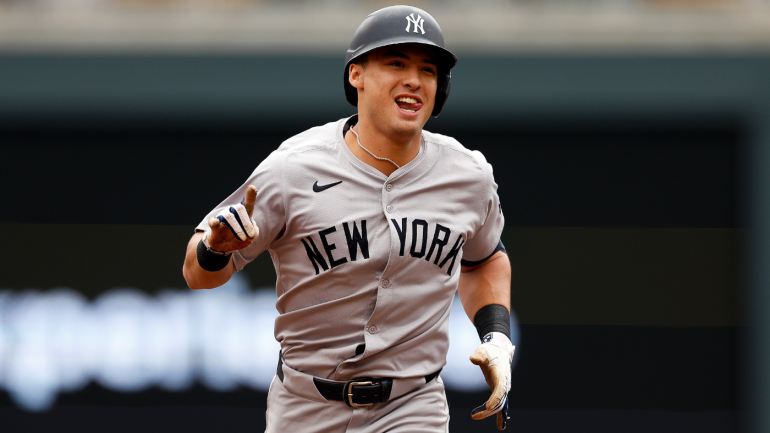
It's funny how baseball works. Follow the game close enough for long enough and certain players will become linked together in your mind. Take Baltimore Orioles shortstop Gunnar Henderson and Arizona Diamondbacks outfielder Corbin Carroll. They entered last season ranked Nos. 1 and 2 on our overall prospect list. They subsequently validated those rankings, winning their respective Rookie of the Year Awards and helping their clubs reach the postseason.
Entering this season, it seemed reasonable to think Henderson and Carroll would continue to perform at similarly high levels. Yet so far this year, the two have taken divergent paths. Whereas Henderson is making good on predictions he'd compete for the Most Valuable Player Award by making loud contact at an unreal frequency, Carroll has been mired in a season-long slump fueled by a bloated pop-up rate. Opponents have spammed him with pitches up in the zone, and he's responded by hitting far too many of them straight up.
We're not ready to give Henderson the hardware just yet, nor are we ready to sound the alarm on Carroll. Their starts did get us checking in some other notable young players, however. Below, we've touched upon how four of them are progressing this season.
1. Anthony Volpe, SS, New York Yankees
There was a lot of talk during spring training about how Volpe was getting away from a pull-happy approach, and how he was prioritizing using the entire field again. We're here to tell you that, unlike most spring narratives, this one had legs.
Volpe has found success during the early going while reshaping his batted-ball profile. He's hitting more grounders and line drives, and he's pulling the ball far less often than he did in 2023. Let's put it this way: he entered Sunday with 22 opposite-field hits on the year; he had 32 all last season.
Anthony Volpe extends his hitting streak to 9 games with a leadoff homer! pic.twitter.com/dSsbHEp4lT
— MLB (@MLB) May 16, 2024
We do feel obligated to note that this is not a return to form for Volpe, the way some have portrayed it. He pulled the ball at least 39% of the time throughout his minor-league career, and clearly he had a good deal of success with that approach. This would be, then, by far the lowest pull rate of his career -- and, additionally, it would represent one of the lowest pull rates in all the majors.
Volpe's philosophical shift at the plate is working for him so far. Combine that with his abundant secondary value -- he's a good defensive shortstop and an efficient basestealer -- and the Yankees have to be tickled with their young infielder's season to date.
2. Brice Turang, 2B, Milwaukee Brewers
The Brewers have excelled this season at getting more production from some batters than could have been reasonably expected entering the year. That includes Turang, who suffered through a miserable rookie season last year that saw him hit .218/.300/.300 over 137 games.
Turang, who we think can be reasonably described as one of the best fielding second basemen in the majors, has upped his OPS by nearly 200 points. He's hitting the ball harder on average, but what's caught our attention is the gains he's made in making contact. Last season, he came up empty on nearly 22% of his swings; this season, he's reduced that rate to 12.7%. That's roughly the difference between a league-average contact rate and vying for one of the five best contact rates in the league.
What can't @BRiCEcTuRANG do 😮 pic.twitter.com/n7x1RUiEmH
— Milwaukee Brewers (@Brewers) May 11, 2024
There are some other changes to Turang's game worth noting. He's hitting significantly more balls on the ground, and while that would generally be accompanied by an increase in pull rate, Turang has actually upped his share of batted balls that are sprayed the opposite way. Here are a few examples of him staying inside fastballs and knocking them to left field for singles.
In fact, Turang entered Sunday tied for second in the majors in base hits to the opposite field on launch angles of five degrees or fewer. Know who was first in that category? His Brewers teammate William Contreras. The Brewers might have themselves a type, and clearly it's working out OK.
3. Spencer Torkelson, 1B, Detroit Tigers
Coming off a 31-homer campaign, this was supposed to be the season that Torkelson put everything together, the way the Tigers envisioned when they took him No. 1 in the 2020 draft. So much for that. He opened the season with 37 consecutive homer-less games, and only recently has he shown signs of regaining his power stroke. What's going on here?
Our read on the situation is that Torkelson may need to rework his swing. Based on the statistic above, you probably wouldn't expect to learn that he entered Sunday with one of the 10 highest average launch angles in baseball. Torkelson has had no problem putting the ball in the air consistently this season; he's just had trouble making that air contact matter.
For some idea on why, let's compare Torkelson with a few other members of the top 10 in a notable category: percentage of balls that were hit between 10 and 30 degrees.
| Player | Average launch angle | 10-30 degrees% |
|---|---|---|
Spencer Torkelson | 20.9 degrees | 20.5% |
22.1 degrees | 35.5% | |
22.7 degrees | 34.6% | |
19.7 degrees | 40.9% | |
22.5 degrees | 26.2% | |
22.6 degrees | 37.2% |
Notice anything? Torkelson has the lowest share of batted balls between 10 and 30 degrees -- and it's not close, as he's in last by more than five percentage points. That, plus his average launch angle, tells us that he's getting too far underneath the ball. You don't have to take our word for it: Torkelson entering Sunday ranked fifth in the majors on batted balls with a launch angle of 50 degrees or higher. For reference, the league has hit .015 (that's not a typo) on balls launched in that range.
We're not suggesting Torkelson needs to get away from skying the ball -- he's strong enough where hitting the ball in the air often is a good idea to maximize his slugging -- but clearly something is off with his depth or plane of contact.
4. Ezequiel Tovar, SS, Colorado Rockies
A weird thing about last year's Rockies team is that they had some brilliant young defenders who would be star-caliber players if they could hit -- that despite playing half their schedule at Coors Field. So far this season, that's changed: center fielder Brenton Doyle and -- who else? -- Tovar are on the right side of the league-average line. (As for the rest of the lineup … the less said the better.)
From a broad perspective, it would be fair to write that Tovar's general profile, a plus defender with double-digit home runs and steals capacity, gives him the chance to post some whopper seasons. Drill down a bit and you'll notice that there's a lot of room for fluctuation.
We'll start with his fielding because that's his true North Star. He's capable of making highlight-reel plays when needed, but the best way to describe his glove is that he always looks in control, even when he has to course-correct. There's an inner peace to Tovar's fielding.
Ezequiel Tovar puts the @Rockies ahead in their home opener! pic.twitter.com/1VqnapkgsZ
— MLB (@MLB) April 5, 2024
All that poise goes away when Tovar steps to the plate because he's one of the most aggressive batters in the majors. Lest you think that's an overzealous statement, consider that he entered this week with the highest offer rate in the majors at 62.5%. His chase rate is, predictably, also near the top of the leaderboards. Some batters, like Bo Bichette or Anthony Santander, swing at everything because they know they can hit everything; Tovar is not one of those batters.
Rather, Tovar's game features a worrisome amount of swing and miss. He's making contact at around the same rate as batters like Elly De La Cruz, Nolan Gorman, and Giancarlo Stanton -- or, you know, middle-of-the-order slugger types. Tovar simply doesn't have their kind of power capacity. He's not going to walk as often as those batters, either.
In our mind, that puts present-day Tovar in a pickle: he has to hit for a high average in order to maintain a respectable slash line. We're just not sold on his ability to do so over the long haul, not without a better approach at the plate. The good news is that his youth (he'll turn 23 in August) and glove will grant him a long runway to figure things out.







